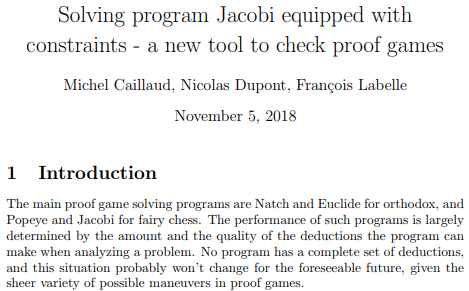
An article by Michel Caillaud, Nicolas Dupont, François Labelle explains and illustrates a new tool to solve some complicated fairy PGs offered by the solving program Jacobi – the possibility to add some constraints in the input.
(with gratitude to the authors for offering this article to JF)
…Jacobi constraints let the user specify some or all of a piece’s generic viagra forum moves. One design goal was to be able to represent the “strategy” notation displayed by Natch and Euclide when solving a proof game, so the notation is somewhat similar. This common notation includes the “-” and “x” symbols, and a minimum number n of moves played by a piece is marked “(n)”…


Great work! Until recently, we knew Jacobi to be the only practical choice for testing fairy proof games. With the constraints option, Jacobi can be useful for testing orthodox PGs that can beat Natch or Euclide.
This is taking steps into an area which hitherto has only been tackled by Mario Richter in his wonderful and little-known Rawbats tool. You guys should really work with him. Where Rawbats still appears beyond Jacobi today is in the ability to do arithmetic to compute the precise number of solutions, without iterating through each actual solution. This obviously depends on a precise understanding of all constraints which can exist.
In Jacobi v0.6.4, I made a small change to constraints notation and the code for problem 2 no longer works. To solve problem 2 with the latest version, you need to change Ra1>d1 to Ra1!d1 (change the greater-than symbol to an exclamation mark for castling moves). Sorry about that.